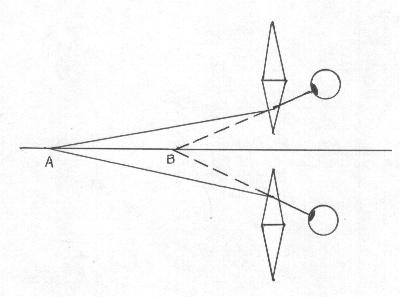
Increased convergence.
A convex or plus lens can be thought of as two prisms cemented together at their bases. Light rays travelling through a prism are bent towards the base. When the eye looks through the center of a convex lens, this effect is absent. But when the axis of the eye and the center of the lens do not coincide, the prismatic effect must be considered.
In the diagram below, the interpupillary distance of the eyes is less than the optical centers of the lenses. The result is that the object appears to be at position B when it is actually at position A. This means that the eyes must converge more than expected.

Increased convergence.
When the accommodation is eliminated through the use of convex reading glasses, it would be beneficial to eliminate or reduce the convergence also. So, the situation shown in the diagram should be avoided. This is particularly important in people with exophoria. That may sound like something terrible, but it is merely a latent difficulty in converging sufficiently when doing a close task. The person may find close work tiring or may be entirely free from any symptoms. Vision tests can reveal this condition. Normally, it is of no importance. But, if much close work is done without accommodation (which normally assists convergence), tired eyes or even double vision can occur.
This problem is of importance only in reading glasses. In the Myopter, since its design eliminates convergence, the small prismatic effect caused by the lenses is of little consequence.
To take this idea one step further, a good case can be made to initially decenter the lenses toward the nose. This results in less convergence being required, as shown in the drawing below. The viewed object is at A but appears to be at B.

Decreased convergence.
The more a lens is decentered, the stronger the effect it will have on the convergence. Decentering a 10 diopter lens 1 mm has the same effect as decentering a 1 diopter lens 10 mm. Both these examples produce what is defined as one prism diopter of deviation, which is a 10 mm deviation at a distance of one meter.
Unfortunately, it takes a fairly strong lens and good deal of displacement to create a significant amount of induced prism. As an example, decentering a +3 D lens 6 mm toward the nose only moves the line of sight outward 0.6 cm at normal reading distance of 33 cm.